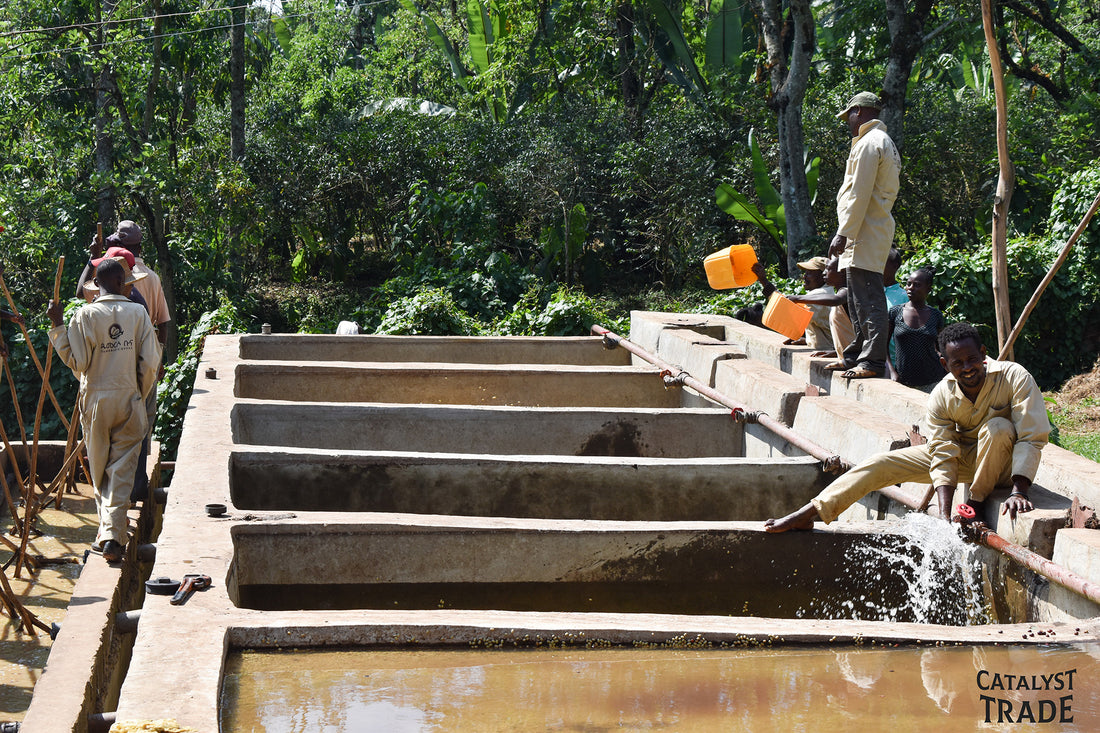
Experimentation and its Discontents
Coffee processing is simultaneously in a golden age and the Wild West right now. If you pick up a bag at some cafes, you’re almost as likely to see something listed like “thermal shock anaerobic natural” as a garden variety washed process. Experimentation is abound, new techniques are spreading like wildfire, and no one can seem to agree on what to call anything. Consumers are being pushed towards expensive, experimental lots with the promise of bigger fruit flavors, but no warning of the fermenty funk that may accompany it.
Here at Elm, we until very recently only purchased washed process coffee. We put a high priority on drinkability in our coffee, our roast style prioritizes sweetness and solubility over absolute flavor clarity, so washed coffee fit our tastes perfectly. Most of the natural processed coffee that came to our cupping table was very one-dimensional, with a strong fruit flavor that often tasted more like the processed food equivalent, with boozy, fermented flavors that made it hard to enjoy a whole cup.
We’ve slowly been changing course however: with this new wave of experimentation in processing, heavily fermented coffees have gotten cleaner. Belayneh Bariso’s coffee is a great example of this brave new world: a single farmer lot from Ethiopia, naturally processed with no obvious ferment flavor.
It’s not just natural process, we’ve been buying anaerobic (or limited oxygen) coffees as well. This technique can be added to both washed and natural process protocols, it’s simply a short fermentation stage in a sealed environment, like a barrel or Grainpro bag. By limiting oxygen’s exposure to the coffee, you promote certain organisms in the fermentation environment and suppress others, usually ending up in a coffee with reduced funk, but all the punchy fruit flavors intact.
However, there is a whole world of new processing out there we still remain fairly hesitant about. Many producers are expanding on their processing by adding various substances to the fermentation environment to affect the process. It can really run the gamut, a short list of additives we’ve encountered are yeasts, fruit, molasses, cinnamon, koji spores, even additional coffee cherry and cascara.
It’s important to note that these additions are not meant to flavor the coffee: adding mango to a fermentation tank is not going to infuse the beans with mango flavor, the molecules from the fruit are simply too large to penetrate the coffee. Rather, these additives modify the fermentation process by adding new microbes and additional sugars, which can boost fruit-like flavors, but not necessarily those fruits added to the coffee. That is the root of what is going on here: producers are expanding the role of fermentation to take a much larger role in cup profile, by introducing additional co-ferments or techniques to have a more direct hand in the process.
These experimental processes are really pushing the envelope of how coffee can taste, and can result in remarkably complex, exciting brews. However, they are just that, experimental: for every mind blowing cup, there are at least as many that show up tasting like cough syrup. This is at exceptional risk to the producer, they often take on heavy costs to process their coffees this way in an attempt to earn higher prices on their crop down the line, and if anything goes wrong, they foot the bill. And even when they end up on the shelves of the cafe, these coffees are eye-wateringly expensive, at least 2 to 3 times more than high quality washed and naturals.
We don’t want to appear too old-fashioned: experimentation in processing has great potential for expanding coffee quality, especially in the face of climate change and economic hardship that has had a significant effect on coffee quality in the past few years. But we do think that many see experimental processing as a quick, +5 cupping score button, and centering your coffee selection around these processes creates some unhealthy expectations of what specialty coffee is. Will it be long before the average consumer turns their noses up at a pristine washed Colombian coffee as “boring?” What are the knock on effects for producers to be rushed into such radical changes, especially while already under pressure from climate change, labor shortages, increased agricultural input costs, inflation, etc? Can anyone actually afford these coffees? Is all this sustainable, not just ecologically, but can this tempo of experimentation continue without leaving people behind?
We’re not closing the door on this entirely: if a yeast inoculated, anaerobic natural process comes to our cupping table and knocks our socks off, we might buy a couple bags. But for Elm, the core of our coffee lineup will always be our first love: washed coffees from small producers.
